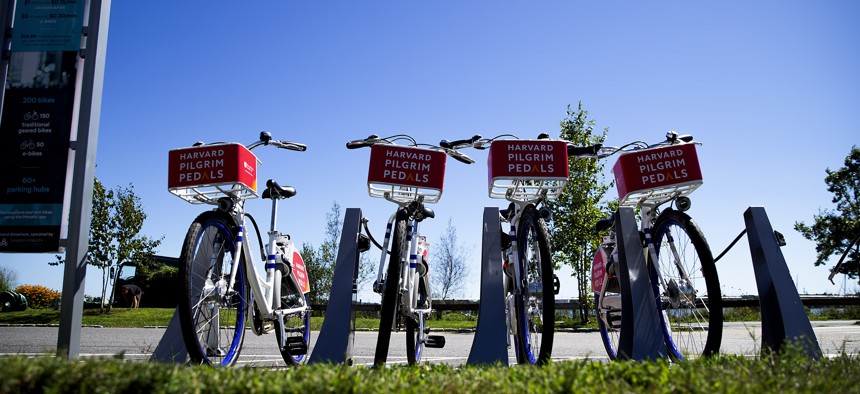A Strong Rebound For Shared Bikes and Scooters

Shared bikes are parked at a station in Portland, Maine. Derek Davis/Portland Press Herald via Getty Images
New figures show the use of “microbility” services returned to near-record high levels last year after a pandemic dip. City policies to manage the devices are also evolving to cut down on problems like cluttered sidewalks.
The popularity of “micromobility” services – such as shared bikes and scooters – surged after the first year of the pandemic, with 2021 becoming the second-busiest year on record, according to a new report.
Last year’s ridership on scooters and bike shares hit 112 million trips, according to the National Association of City Transportation Officials. That was nearly double the number of trips from 2020. The highest ridership on record came in 2019, when those services provided 136 million trips.
The quick rebound for shared bikes and scooters was aided by the growing number of e-bikes for rent, along with policies cities implemented to make sure the devices were better deployed to a broader swath of neighborhoods.
More than 70% of bikeshare providers offered e-bikes by the end of 2021, according to NACTO, and the electric bikes were more popular than traditional pedal bikes. In New York City, for example, e-bikes made up 20% of the Citi Bike fleet, but they accounted for nearly a third of all trips taken. Likewise, e-bikes made up 13% of the bikes offered by Capital Bikeshare in Washington, D.C., but provided 23% of trips.
The group said the decision by bikeshare systems helped fuel bigger changes.
“Bike sales skyrocketed in 2020 and 2021; across the two years, people in the U.S. spent $15 billion on personal bicycles and bike accessories. A major driver of this bicycle boom? Shared micromobility, and more specifically, shared electric bikes,” NACTO wrote in a new report.
“Shared e-bike trips nearly doubled from 9.5 million in 2018 to 17 million in 2021. The growth in shared e-bike trips can be almost entirely attributed to the adoption of e-bikes in station-based systems. By the end of 2021, two-thirds of station-based bike share systems had e-bikes, and a quarter of all station-based system bikes in the U.S. were electric. Riders took 14.5 million e-bike trips in station-based systems in 2021—an almost 30-fold increase over 2018 (500,000 trips),” the group added.
In an accompanying policy brief, NACTO explained that cities are taking a more hands-on approach to bikeshare and scooter services in recent years. City governments are selecting exclusive vendors, regulating where devices can be parked, and more explicitly spelling out where the devices must and must not go. That means making sure the deployment is equitable, as well as prohibiting them in crowded areas.
The active involvement of city officials in shaping policies for shared scooters and bikes lately is a marked shift from just a few years ago, when many cities let dockless bikeshare companies and scooter providers experiment with different strategies to lure customers. That spurred public backlash to the nascent industry in many places, like Dallas, where a glut of shared bikes clogged sidewalks and cluttered streets.
Now, though, cities are working out longer-term licenses with fewer vendors to keep tighter control over the services.
That has become an increasingly important point, as the industry has struggled financially. Several micromobility companies have laid off employees in recent months. The scooter provider Bird, once a Silicon Valley “unicorn” valued at more than $1 billion, has exited many cities and warned investors it might have to close up shop, after its stock prices have tanked.
“By carefully selecting operators and limiting the number of operators in a given city, cities are shaping micromobility programs that provide better benefits for their residents, as well as a stable operating environment for the companies operating shared bikes and scooters,” NACTO wrote in its policy brief.
Many cities are also providing on-street parking sites or imposing “lock-to” requirements so that the devices don’t impede foot, bicycle or wheelchair traffic.
NACTO, which has long advocated for streetscapes that better accommodate pedestrians and cyclists, said improved infrastructure could encourage ridership of shared bikes and scooters, while also addressing many of the problems associated with them.
“On 10th Street in Atlanta, city staff found that under normal conditions, 1 in 3 people on bicycles and e-scooters choose to ride on the sidewalk,” NACTO noted in its policy brief. “When the city implemented a week-long pop-up bikeway, however, staff found that only 1 in 15 people chose to ride on the sidewalk.”
Corinne Kisner, NACTO’s executive director, said shared scooters and bikes could have benefits for cities overall.
“Well-designed micromobility programs mean safer, more sustainable and resilient cities,” she said in a statement. “By redesigning streets, lowering speeds, and prioritizing bikeway projects, local leaders can ensure that the bike and scooter boom continues to gain momentum, connecting people to the opportunities in their cities.”
Daniel C. Vock is a senior reporter for Route Fifty based in Washington, D.C.
NEXT STORY: Maine’s 3D-printed Wood-fiber Home






